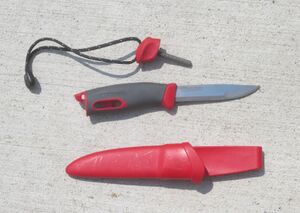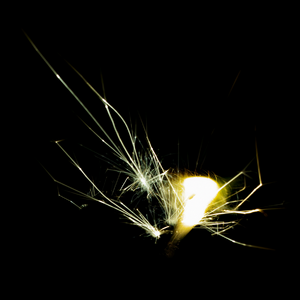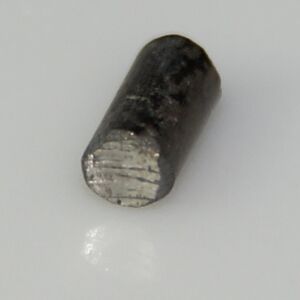فروسريوم
الفروسريوم (Ferrocerium، يُعرف في أوروپا باسم أويرميتال Auermetall)، هي سبيكة اصطناعية تلقائية الاشتعال من فلزات خليطة (السريوم، اللانثانوم، النيوديميوم، اللانثانيدات النادرة الأخرى، وبعض الحديد (حوالي 95% لانثانيدات و5% حديد) تُصلّب بخلطها بأكاسيد بلحديد و/أو المغنسيوم. عند اصطدامها بمادة أكثر صلابة، يُنتج الاحتكاك شظايا ساخنة تتأكسد بسرعة عند تعرضها للأكسجين في الهواء، مُنتجةً شرارات قد تصل درجات حرارتها إلى 3315°س. يعود هذا التأثير إلى انخفاض درجة اشتعال السريوم، بين 150 و180°س.
للفروسروم استخدامات تجارية عديدة، كمصدر إشعال للولاعات، مشعلات مشاعل اللحام والقطع بالغاز، إزالة الأكسدة في علم الفلزات، وقضبان الفروسريوم. ونظراً لقدرة الفروسريوم على الاشتعال في الظروف المعاكسة، تُستخدم قضبان الفروسريوم (والتي تُسمى أيضاً قضبان الفـِرو، وقضبان الشرر، ومشعلات الشرر المصنوعة من الصوان[1]) تُستخدم عادة لإشعال نار في حالات الطوارئ في أدوات البقاء.[2] يُطلق على الفروسريوم في هذه الحالة اسم "الصوان"، حيث يُستخدم كلاهما في إشعال النار. إلا أن الفروسريوم والصوان الطبيعي لهما آلية عمل متعاكسة.
الاكتشاف
Ferrocerium alloy was invented in 1903 by the Austrian chemist Carl Auer von Welsbach. It takes its name from its two primary components: iron (from لاتينية: ferrum), and the rare-earth element cerium, which is the most prevalent of the lanthanides in the mixture. Except for the extra iron and magnesium oxides added to harden it, the mixture is approximately the combination found naturally in tailings from thorium mining, which Auer von Welsbach was investigating.[3] The pyrophoric effect is dependent on the brittleness of the alloy and its low autoignition temperature.[4]
التركيب
In Auer von Welsbach's first alloy, 30% iron (ferrum) was added to purified cerium, hence the name "ferro-cerium". Two subsequent Auermetalls were developed: the second also included lanthanum to produce brighter sparks, and the third added other heavy metals.
A modern ferrocerium firesteel product is composed of an alloy of rare-earth metals called mischmetal, containing approximately 20.8% iron, 41.8% cerium, about 4.4% each of praseodymium, neodymium, and magnesium, plus 24.2% lanthanum.[5] A variety of other components are added to modify the spark and processing characteristics.[2] Most contemporary flints are hardened with iron oxide and magnesium oxide.
الاستخدامات

Ferrocerium is used in fire lighting in conjunction with a striker, similarly to natural flint-and-steel, though ferrocerium takes on the opposite role to the traditional system; instead of a natural flint rock striking tiny iron particles from a firesteel, a striker (which may be in the form of a hardened steel wheel) strikes particles of ferrocerium off of the "flint". This manual rubbing action creates a spark due to cerium's low ignition temperature between 150–180 °C (302–356 °F). Any material that is harder than the rod itself may be used to produce sparks. Though the striker must have a sharp corner, sharp edge, or a knurled surface in order to produce sparks, carbon steel is not required. The idea that carbon steel is needed to produce sparks from a ferrocerium rod is an oft repeated myth, though carbon steel does make the spark more prevalent when striking. [6]
Ferrocerium is most commonly used to start Bunsen burners and oxyacetylene welding torches.[بحاجة لمصدر]
About 700 tons were produced in 2000.[بحاجة لمصدر]
المصادر
- ^ MacWelch, Tim. "The Best Spark Rods (And How To Use Them)". Retrieved October 6, 2022.
- ^ أ ب Reinhardt, Klaus; Winkler, Herwig (2000). "Cerium Mischmetal, Cerium Alloys, and Cerium Compounds". Ullmann's Encyclopedia of Industrial Chemistry. John Wiley & Sons. doi:10.1002/14356007.a06_139. ISBN 3527306730.
- ^ van Weert, Ad; van Weert, Alice; Bromet, Joop (1995). The Legend of the Lighter. New York, NY: Abbeville Press. p. 45. ISBN 9781558598546.
- ^ Hirch, Alcan (2 September 1920). "Ferrocerium, its manufacture and uses". Iron Age. Chilton Company. 106: 575–576 – via Google Books.
- ^ "Ferrocerium rods". Jiangxi Metals Co., Ltd. 2008. Archived from the original on 24 October 2008 – via Alibaba.com.
- ^ W., Anthony. "The Science Behind Ferro Rods: How They Work to Start Fires". Everstrikematch.com. Retrieved 20 November 2024.
وصلات خارجية
- Jorgenson, John D.; Corathers, Lisa A.; Gambogi, Joseph; Kuck, Peter H.; Magyar, Michael J.; Papp, John F.; Shedd, Kim B. (2006). "Minerals Yearbook 2006: Ferroalloys" (PDF). United States Geological Survey. Archived from the original (PDF) on 2013-08-06. Retrieved 2009-04-24.
- CS1: Julian–Gregorian uncertainty
- Short description is different from Wikidata
- Articles with hatnote templates targeting a nonexistent page
- Articles containing لاتينية-language text
- مقالات ذات عبارات بحاجة لمصادر
- Portal-inline template with redlinked portals
- Pages with empty portal template
- سبائك حديدية
- إشعال النار
- مواد تلقائية الاشتعال


